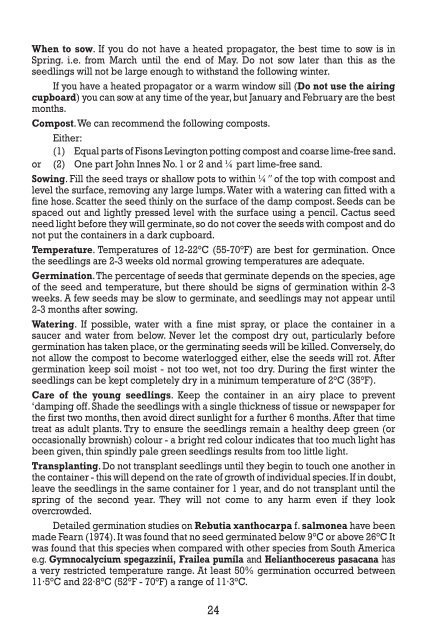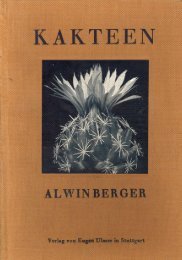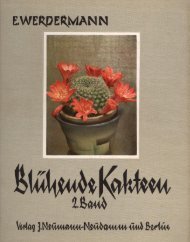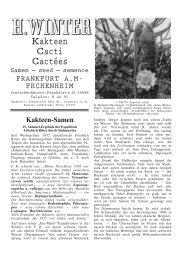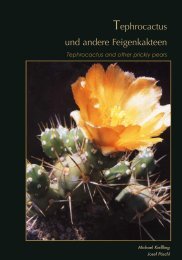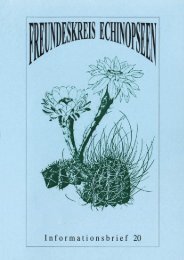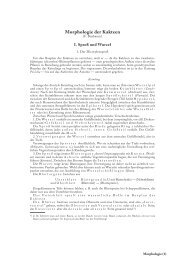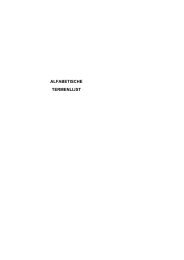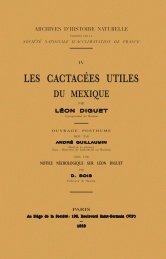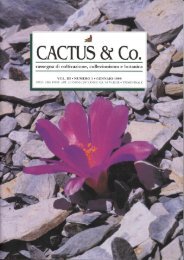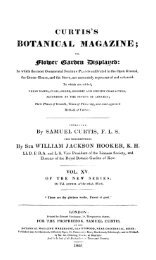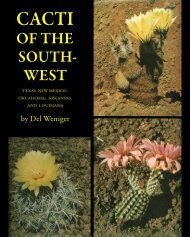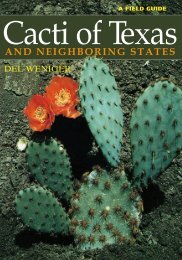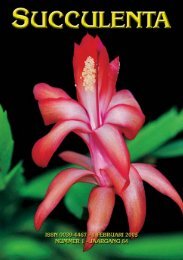the genus rebutia 1895—1981 - Free
the genus rebutia 1895—1981 - Free
the genus rebutia 1895—1981 - Free
You also want an ePaper? Increase the reach of your titles
YUMPU automatically turns print PDFs into web optimized ePapers that Google loves.
When to sow. If you do not have a heated propagator, <strong>the</strong> best time to sow is in<br />
Spring. i.e. from March until <strong>the</strong> end of May. Do not sow later than this as <strong>the</strong><br />
seedlings will not be large enough to withstand <strong>the</strong> following winter.<br />
If you have a heated propagator or a warm window sill (Do not use <strong>the</strong> airing<br />
cupboard) you can sow at any time of <strong>the</strong> year, but January and February are <strong>the</strong> best<br />
months.<br />
Compost. We can recommend <strong>the</strong> following composts.<br />
Ei<strong>the</strong>r:<br />
(1) Equal parts of Fisons Levington potting compost and coarse lime-free sand.<br />
or (2) One part John Innes No. 1 or 2 and ¼ part lime-free sand.<br />
Sowing. Fill <strong>the</strong> seed trays or shallow pots to within ¼'' of <strong>the</strong> top with compost and<br />
level <strong>the</strong> surface, removing any large lumps. Water with a watering can fitted with a<br />
fine hose. Scatter <strong>the</strong> seed thinly on <strong>the</strong> surface of <strong>the</strong> damp compost. Seeds can be<br />
spaced out and lightly pressed level with <strong>the</strong> surface using a pencil. Cactus seed<br />
need light before <strong>the</strong>y will germinate, so do not cover <strong>the</strong> seeds with compost and do<br />
not put <strong>the</strong> containers in a dark cupboard.<br />
Temperature. Temperatures of 12-22°C (55-70°F) are best for germination. Once<br />
<strong>the</strong> seedlings are 2-3 weeks old normal growing temperatures are adequate.<br />
Germination. The percentage of seeds that germinate depends on <strong>the</strong> species, age<br />
of <strong>the</strong> seed and temperature, but <strong>the</strong>re should be signs of germination within 2-3<br />
weeks. A few seeds may be slow to germinate, and seedlings may not appear until<br />
2-3 months after sowing.<br />
Watering. If possible, water with a fine mist spray, or place <strong>the</strong> container in a<br />
saucer and water from below. Never let <strong>the</strong> compost dry out, particularly before<br />
germination has taken place, or <strong>the</strong> germinating seeds will be killed. Conversely, do<br />
not allow <strong>the</strong> compost to become waterlogged ei<strong>the</strong>r, else <strong>the</strong> seeds will rot. After<br />
germination keep soil moist - not too wet, not too dry. During <strong>the</strong> first winter <strong>the</strong><br />
seedlings can be kept completely dry in a minimum temperature of 2°C (35°F).<br />
Care of <strong>the</strong> young seedlings. Keep <strong>the</strong> container in an airy place to prevent<br />
‘damping off. Shade <strong>the</strong> seedlings with a single thickness of tissue or newspaper for<br />
<strong>the</strong> first two months, <strong>the</strong>n avoid direct sunlight for a fur<strong>the</strong>r 6 months. After that time<br />
treat as adult plants. Try to ensure <strong>the</strong> seedlings remain a healthy deep green (or<br />
occasionally brownish) colour - a bright red colour indicates that too much light has<br />
been given, thin spindly pale green seedlings results from too little light.<br />
Transplanting. Do not transplant seedlings until <strong>the</strong>y begin to touch one ano<strong>the</strong>r in<br />
<strong>the</strong> container - this will depend on <strong>the</strong> rate of growth of individual species. If in doubt,<br />
leave <strong>the</strong> seedlings in <strong>the</strong> same container for 1 year, and do not transplant until <strong>the</strong><br />
spring of <strong>the</strong> second year. They will not come to any harm even if <strong>the</strong>y look<br />
overcrowded.<br />
Detailed germination studies on Rebutia xanthocarpa f. salmonea have been<br />
made Fearn (1974). It was found that no seed germinated below 9°C or above 26°C It<br />
was found that this species when compared with o<strong>the</strong>r species from South America<br />
e.g. Gymnocalycium spegazzinii, Frailea pumila and Helianthocereus pasacana has<br />
a very restricted temperature range. At least 50% germination occurred between<br />
11∙5°C and 22∙8°C (52°F - 70°F) a range of 11∙3°C.<br />
24<br />
spegazinnii -><br />
spegazzinii


